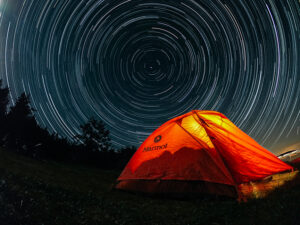Reader John O’Bright asked recently:
Could you please share your knowledge about the difference between closed-cell and open-cell foam for cold weather sleeping pads? You noted that you switched from using two close-cell foam pads to a two-inch open-cell foam pad. How does the open-cell foam compare to the CCF in terms of weight and bulk? Would you share the name of the manufacturer of the open-cell foam you use?
On my first expedition, I slept poorly in part because 2.5 centimetres (one inch) of closed-cell foam just wasn’t warm enough, especially with a marginal bag. I soon changed to a two-inch thick, open-cell foam pad that came with the sleeping bag. This bag doesn’t have down on the bottom; the pad slips into an envelope beneath. One advantage of this system is that you never accidentally roll off your sleeping pads.
However, this is an extremely bulky bag. Stuffed, it is about the size of a large garbage bag full of leaves. A good part of that bulk is the open-cell foam. It’s fine on big sleds during multi-week odysseys, but I would not want to carry it on a backpack.
Although the open-cell foam is covered with a light drycleaning bag, there is little moisture at polar temperatures to worry about. Snow behaves like white dust. And the pad is, in fact, extremely warm: I once tested a variety of winter items, including pads, at a thermophysiologist’s lab. We attached thermocouples to my back, rear end, legs, etc., then I lay in a freezer at about -20°C. The open-cell foam outperformed even a caribou skin rug, which Inuit up north sometimes use in their bush tents.
I also carry a closed-cell foam pad to sit on while cooking, plus a Crazy Creek-type chair, which really gives your back a break. These all go under the sleeping bag at night. You can’t have too much insulation beneath you.
Some polar trekkers like Therm-a-Rests. Although I use a compact model of Therm-a-Rest for sea kayaking, where space is at a premium, in winter I don’t want to risk anything that can puncture. In summer, it’s easy to find out where a leak is: Just sprinkle water on the pad and look for bubbles. But that’s awkward in winter, when you’re melting all water and it instantly freezes on surfaces.
By the way, down air mattresses do not work in polar temperatures, despite what some manufacturers claim.
I’m sure there’s open-cell foam out there that you can cut to form. No need to get my particular bag, if you already have a model you’re happy with.






